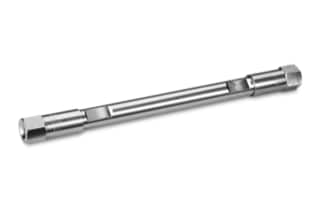
|
Chemistry |
C18 |
|
Separation Mode |
Reversed Phase |
|
Particle Substrate |
Silica |
|
pH Range Min |
2 pH |
|
pH Range Max |
8 pH |
|
Temperature Limits |
45 C |
|
Maximum Pressure |
6000 psi (415 Bar) |
|
Endcapped |
No |
|
Bonding Technology |
C18 SB |
|
Silanol Activity |
High |
|
Particle Shape |
Spherical |
|
Particle Size |
3.5 µm |
|
Endfitting Type |
Waters |
|
Pore Size |
100 Å |
|
Format |
Column |
|
Surface Area |
230 |
|
System |
HPLC |
|
Particle Technology |
HSS |
|
USP Classification |
L1 |
|
Inner Diameter |
4.6 mm |
|
Length |
100 mm |
|
Carbon Load |
8.5 % |
|
UNSPSC |
41115709 |
|
Brand |
XSelect |
|
Product Type |
Columns |
|
Units per Package |
1 pk |

XSelect HSS C18 SB Column, 100Å, 3.5 µm, 4.6 mm X 100 mm, 1/pk
The HSS C18 SB (Selectivity for Bases) column is a non-end-capped, low-coverage C18 bonded-phase column designed specifically to increase silano-philic interactions. This produces a different selectivity than a high-coverage fully-end-capped C18 column, especially for basic compounds.
The XSelect HSS C18 SB Column is intended for 'Selectivity for Bases.' It is an un-end-capped, low-coverage C18 bonded phase Column that has been specifically designed to aid in increased silano-phonic interactions. The design of the XSelect HSS C18 SB Column allows it to have a different analyte selectivity than high-coverage, stationary phase bearing fully end-capped C18 Columns.
Waters' HSS—High Strength Silica technology was used to develop the XSelect HSS C18 SB Column, which was designed to improve the chromatographic performance of 'Ethylene Bridged Hybrid' - BEH and 'Charged Surface Hybrid' - CSH particles. The XSelect HSS C18 SB Column's properties enable it to withstand UPLC pressures, making it fully scalable and transferable to UPLC separations and allowing the Column to provide additional benefits in your system, such as different selectivity and higher polar compound.
Multiple particle technologies are needed to handle complex samples in order to enable a thorough chromatographic analysis of various food varieties and other compounds. Waters has designed a wide range of laboratory equipment, including columns that use unique, distinct, and proprietary particle technologies to provide exceptional operational stability in your lab. You will be able to overcome any chromatographic challenges by using carefully selected ligands to complement CSH and HSS technologies in Waters products.
You can shop for lab equipment through the Waters online store on our website to ensure that you have quality products for your analytical needs. You may also be interested in XSelect HSS C18 SB VanGuard Cartridge, 100Å, 3.5 µm, 3.9 mm X 5 mm, 3/pk; By removing particulate contamination from the mobile phase stream, XSelect HSS C18 SB VanGuard Cartridges are used to increase analytical column lifetime and performance. This cartridge has been designed to protect all 4.6 mm I.D. XSelect HSS C18 SB analytical columns with 3.5 µm sorbent particles.
What Are the Best Analyte Isolation and Cleaning Methods?
There are two common SPE techniques used for separating and preparing sample components of interest. A retention-cleanup-elution strategy is frequently used when the concentrations of the compounds of interest are too low for accurate and precise quantification. This method enables the concentration of dilute samples as well as the trace enrichment of compounds. A pass-through cleanup strategy may be used when the desired sample component is present in high concentration; however, no sample enrichment occurs when a pass-through cleanup strategy is used.